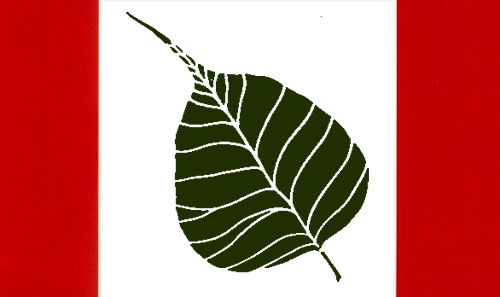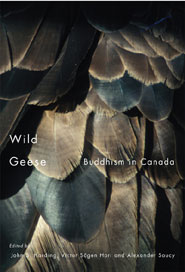
O Canada! Happy Canada Day!
To celebrate I spent the morning flipping through Wild Geese, a solid, comprehensive study of Buddhism in Canada, edited by John S. Harding, Victor Sogen Hori, and Alexander Soucy (McGill-Queen’s University Press, 2010). It goes over the history of the religion in Canada, looks at various Canadian Buddhist communities, and contains the biographies of a couple of Buddhist leaders in Canada.
 In 1905, the Reverend Sasaki Senju, of the Honganji Temple—a head temple of the Japanese True Pure Land tradition—came to Canada to build the first Buddhist temple there. The first sixty years of Buddhism’s one hundred year history in Canada is basically a story of Japanese Pure Land Buddhists trying to establish themselves in a new place. And not just a new place, but a hostile new place—as Sogen Hori points out in the book’s first chapter, Canadian federal policies were explicitly racist at the turn of the nineteenth century. Asians couldn’t vote or own property.
In 1905, the Reverend Sasaki Senju, of the Honganji Temple—a head temple of the Japanese True Pure Land tradition—came to Canada to build the first Buddhist temple there. The first sixty years of Buddhism’s one hundred year history in Canada is basically a story of Japanese Pure Land Buddhists trying to establish themselves in a new place. And not just a new place, but a hostile new place—as Sogen Hori points out in the book’s first chapter, Canadian federal policies were explicitly racist at the turn of the nineteenth century. Asians couldn’t vote or own property.
In the 1970s Canada changed its stance on official racism and overhauled its immigration policies [Jeff Wilson points out below that Canadian immigration reform happened in 1967]. Floods of immigrants from Buddhist countries started coming in. At about that same time, Buddhism began to spread outside the immigrant communities and into the lives of Westerners.
This book looks like it’s worth picking up for anybody interested in Buddhism in the West, particularly because there is so little information out there specifically on how Buddhism is taking shape in Canada—the True North strong and free!
Pick up a copy here.
Also check out the online guide to Buddhism in Canada.